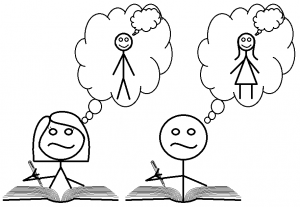For a male writer (like me), it’s difficult to write a story in a female character’s point of view. I’ve read that it’s also difficult for female writers to get into a male character’s head and write realistic stories. Still, we’ve all read books by authors who did this very well. If others have done it; you can too.
 Advance warning: this post is full of opinions that may sound stereotypical and sexist. As a caveat, let me say the characteristics I’ll ascribe to women and men are generalizations. Not all men, nor all women, are as described below. There is plenty of overlap in thoughts and behaviors between genders.
Advance warning: this post is full of opinions that may sound stereotypical and sexist. As a caveat, let me say the characteristics I’ll ascribe to women and men are generalizations. Not all men, nor all women, are as described below. There is plenty of overlap in thoughts and behaviors between genders.
Your goal, as a writer, is to produce an entertaining and meaningful experience for your readers. Say you’re female and your lead Point of View character is male. You want readers of both genders to enjoy the story and not get jolted out of it with thoughts of “No guy would think (or do) that!”
Of course, all fiction writing involves getting into someone else’s head, someone different from you. Even characters who share your gender have personalities unlike yours, so you’re always setting your own feelings and motivations aside as you write what someone else would think, say, or do.
Writing from the other gender’s POV is like that, only a bit more so. Think of the following suggestions as tendencies, directions in which to stretch a little without going too far.
For you male writers dealing with a female POV character:
- Ensure she takes in the appearances of things, and notices minute changes over time
- Have her look into other characters’ eyes
- Employ more dialogue, especially small talk
- Allow her to comment on others’ appearances, clothes, and health
- Have her care more about other character’s feelings, and to validate them
- Make her more willing to share her own feelings with others
- Ensure she talks more about people, their connections, and feelings
- Show her inner feelings more frequently and more deeply
- Have her think about people as a network, where each person is on a spectrum between nice/good and mean/bad, and connecting lines between people are strong or weak based on how the two interact
For you female writers dealing with a male POV character:
- As he takes in a scene, ensure he focuses more on the functions of things, even how he could use or change them
- Have him look around more at a scene than into other characters’ eyes
- Make his dialogue more sparse, with less small talk
- Have him care more about other characters’ problems (and how he could solve them) than their feelings
- Make him reluctant to disclose his feelings to other characters
- Ensure he talks more about objects and abstract concepts
- Have his thoughts move quickly from feelings to action (i.e. what is he going to do?)
- Have him think about people as being in hierarchies, ranking either higher or lower than him, and how to treat them appropriately
Others have written about the process of creating a convincing opposite-sex POV character. For example, Author Shaquanda Dalton suggests focusing more on the similarities between the genders. She recommends concentrating on dialogue and getting help from opposite-sex beta readers. She also says that the thoughts of fictional characters will focus on the plot problem whether they are women or men, and won’t be significantly different. Lastly, she urges writers to observe real people to get ideas for character actions.
Author A. L. Sowards believes there are differences in the way men and women think, and a writer should keep these in mind. Women, she states, often stew over upsetting things longer, while men get angry but let it go quickly. Women think about many things at once, while men focus on one. She claims it’s untrue that women are more detail-oriented; it’s more a matter of interests. A female character might describe flowers using more specifics, but a male character would describe all the facets of a car engine in the same degree of detail. She advises writers to read books written by and about the opposite gender, and to get to know the character’s personality, strengths, and weaknesses well.
We may try, in our modern age, to dismiss any differences between the genders, but on average, there are some characteristics common to women and others typical of men. You should understand these differences, so you can become capable of writing from the POV of either gender.
Looking back, I’ve only done this with two characters in my published stories— Dr. Anusha Bharateeyanakshatra in “The Finality” and Galene in “Against All Gods.” It’s up to readers whether these female characters were realistically portrayed by—
Poseidon’s Scribe
